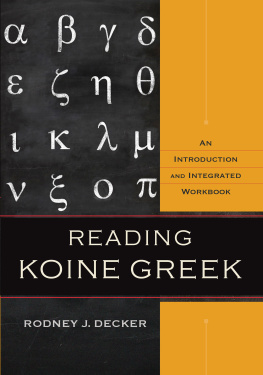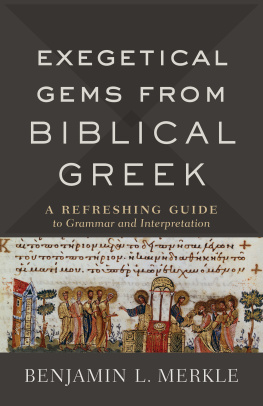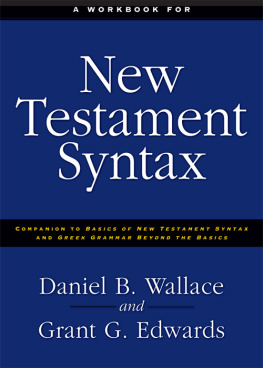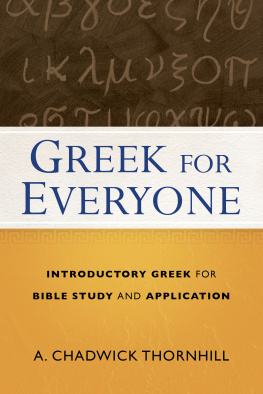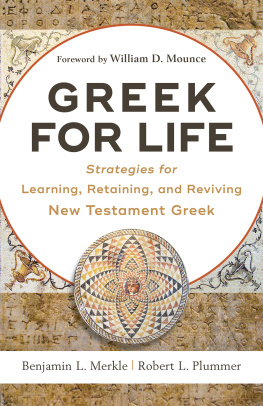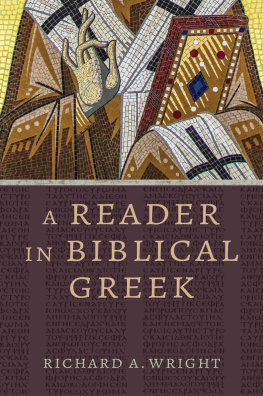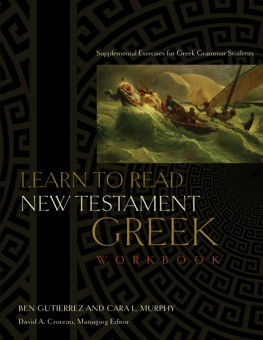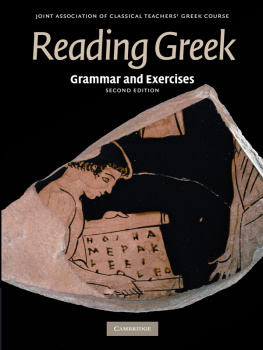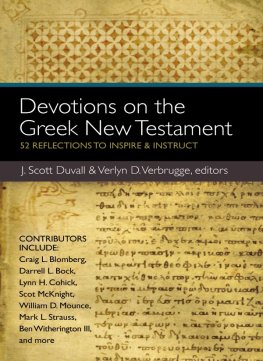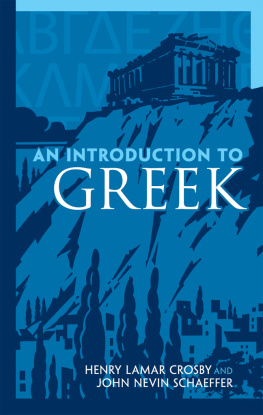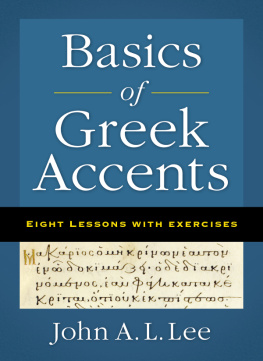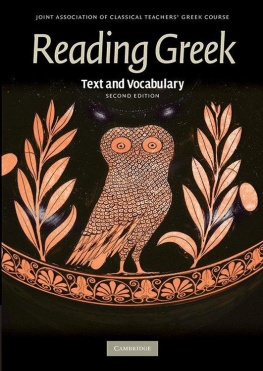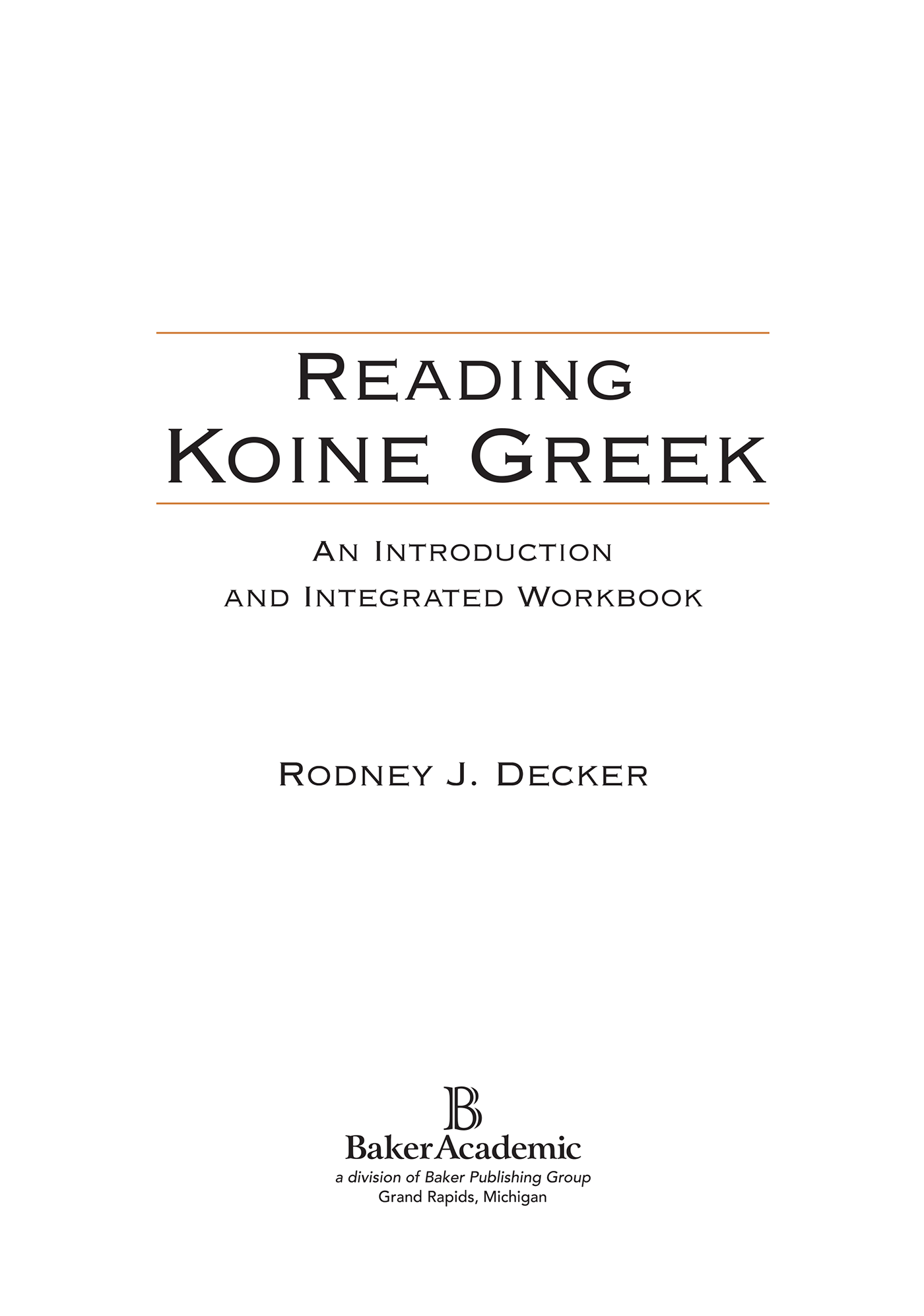
2015 by Rodney J. Decker
Published by Baker Academic
a division of Baker Publishing Group
P.O. Box 6287, Grand Rapids, MI 49516-6287
www.bakeracademic.com
Ebook edition created 2015
All rights reserved. No part of this publication may be reproduced, stored in a retrieval system, or transmitted in any form or by any meansfor example, electronic, photocopy, recordingwithout the prior written permission of the publisher. The only exception is brief quotations in printed reviews.
ISBN 978-1-4934-0410-0
Library of Congress Cataloging-in-Publication Data is on file at the Library of Congress, Washington, DC.
Unless otherwise indicated, all Scripture quotations are the authors translation.
To my Greek teachers
Robert J. Williams
William E. Arp
Kenneth I. Brown
W. Edward Glenny
C ONTENTS
E XPANDED T ABLE OF C ONTENTS
A CKNOWLEDGMENTS
I have dedicated this book to my formal Greek teachers. Doc Williams introduced a college sophomore to the language. Dr. Bill Arp, who is now my colleague and friend, taught the undergrad junior and senior Greek classes. Dr. Ken Brown, my ThM adviser, captivated me with textual criticismand told me that I might be able to write someday. Years later my Doctorvater , Ed Glenny, assigned me Porters Verbal Aspect in his Advanced Greek Grammar seminarand I found not only my dissertation topic in those dense pages but also a love for grammar. Without the tutelage of these four men, I would not have the foundation to attempt my own grammar.
One other prof deserves mention. Though he was not one of my language teachers, Dr. Richard Engle was one of the chief reasons why I persevered in Greek. He came to the classroom after ten years of pastoral ministry. In his theology and Bible classes, I saw a blend of the biblical languages, theology, and ministry, which convinced me that if I was serious about Scripture, I had to be serious about the biblical languages. Dicks example guided my attempt at a similar integration for the dozen years I spent in the pastorate and is the vision that I now try to communicate to my students who aspire to pastoral ministry.
My other academic and linguistic debts are in printed form. No one can ever catalog (or even remember) the wide-ranging influence of the books and articles, lectures and sermons, that have shaped their thinking. From that constellation two deserve mention in the context of this book. Moiss Silvas God, Language and Scripture transformed my understanding of and approach to the biblical languages. I read it when it was first published, my last year in the pastorate. My beginning attempts to teach Greek the following fall were quite different from what they would otherwise have been. It is a relatively slender volume, but some things on earth are small, yet they are extremely wise (Prov. 30:24 NIV). The other is the work of D. A. Carson. Whether with his explicitly linguistic works on exegesis and accents or his deft handling of Scripture in his commentaries, he has modeled a capable and responsible approach to the text. The method of these two scholars is what I have come to describe as grammatical minimalism in contrast to a maximal, golden nuggets approach. That is, the most appropriate way to handle the interpretation of an ancient text (or a modern one, for that matter) is to place the least weight on the individual grammatical pieces and the greatest weight on statements in their context.
My students, too many to list, deserve my thanks. I have learned a great deal about Greek from answering the questions of hundreds of students over the years. A special thanks to those students in the last few years who spotted errata, clumsy explanations, and missing pieces as this book took shape for publication. My teaching assistant (TA) and PhD student Mark Mills has been exceptionally helpful in revising, clarifying, and proofing the manuscript. Dan Fabricatore has given valuable help and feedback while teaching my online Greek course with this material for a number of years and was my TA when he was a PhD student. Another of my former doctoral students, Neal Cushman of Northland International University, facilitated the use of this book in manuscript form for the past three years as a pilot project. The feedback that I have received from Bryan Blazosky and his TAs at Northland has helped shape the structure of the book and shown me where other instructors may not understand how or why I have done certain things. Rodney Whitacre, Stephen Carlson, Moiss Silva, Jay Smith, and Bill Combs read all or significant parts of the manuscript at various stages and provided many helpful suggestions and comments. Carl Conrad has been generous with his help over the years as we have corresponded about a great many of the grammatical matters included in this book. Any deficiencies, errors, or peculiarities that remain are certainly not due to the abundance of help that I have received; I accept the responsibility for such matters.
I would be remiss if I did not also acknowledge with gratitude the provisions of my dean, Mike Stallard, and provost, Jim Lytle. They have been generous in adjusting my teaching load and other responsibilities so that I could have time to study and write. At the beginning of my teaching career, Don Urey, then academic dean and later president of Calvary Bible College, took a chance on a young pastor who thought that he wanted to teach. Although I have taught many classes in the quarter century since he opened academias doors to me, by choice I have always taught first-year Greek.
The editorial team at Baker Academic has been a great help in a very technical project. With James Ernests recruiting efforts and his continuing encouragement, interaction, and critique; the superb copyediting by Amy Donaldson; and Wells Turners skillful editing and coordination of the design and production, it has been a joy to work with their team.
Not a mere formality, I owe heartfelt thanks to my wife, Linda, for creating a home environment where I can write. Even on those long days when I spend many hours in my study, she understands. The winter when circumstances largely restricted my writing to a chair by the fire created considerable extra work for her; I am grateful. She has gone above and beyond in caring for not only me and our home but also our aging and sometimes invalid parents over the years, now having several times shared her home with one of them in their final years.
The map in the introduction is based on an outline map created by Joy A. Miller of Five Js (http://fivejs.com) and is used by permission. The Greek Alphabet Song in chapter 1 was written by Ben McGrew and is used with his permission; the score was converted to digital form by Alex Morris from the handwritten original. The illustrations in chapter 9 and at the end of chapter 23 were drawn by Levi Schooley and Cynthia Taylor respectively.
Photos included are used by permission of their owners:
| Figure I.1 | Mycenaean, Linear B Greek Tablet, National Archaeological Museum, Athens. Photo courtesy of John S. Y. Lee, Hong Kong |
| Figure I.2 | Archaic Athenian Inscription, L. H. Jeffery Archive, Centre for the Study of Ancient Documents, Oxford |
| Figure 1.4 | , The John Rylands University Library, University of Manchester |
| Figure 1.5 | Manuscript GA 545, Special Collections Library, University of Michigan; photo provided by the Center for the Study of NT Manuscripts |
| Figure 15.1 | (POxy 1227), Robert C. Horn Papyri Collection, Trexler Library, Muhlenberg College, Allentown, Pennsylvania |
Next page
